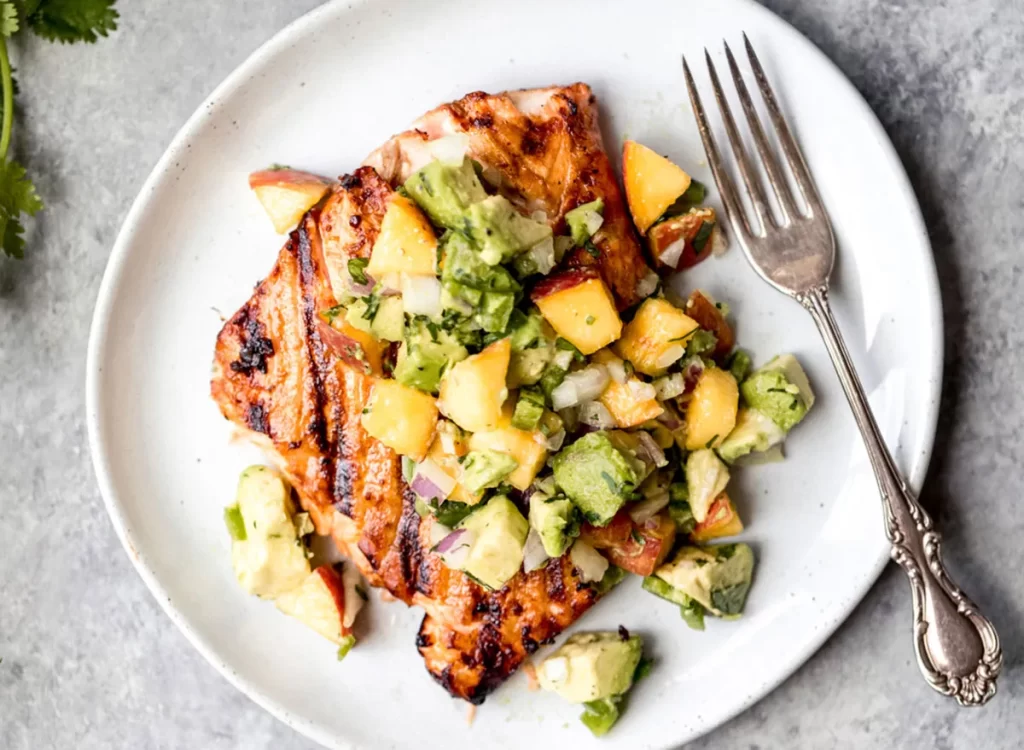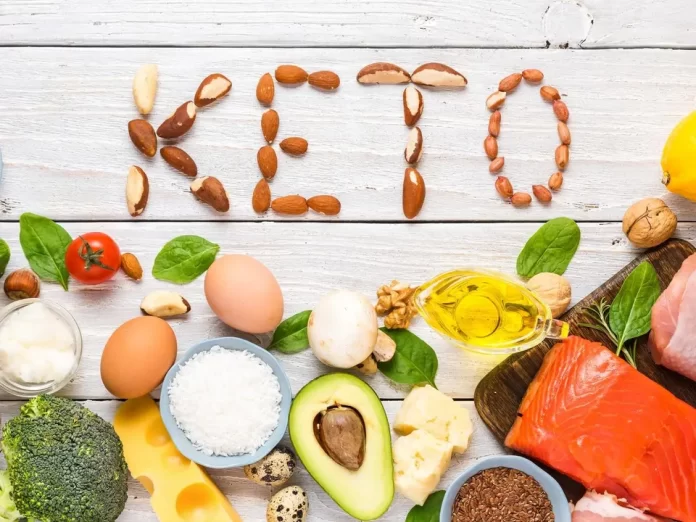If you’re here, chances are you’ve heard the buzz about the keto diet and are curious to see what it’s all about. Maybe you’ve seen those Instagram-worthy plates piled high with avocado and bacon, or maybe you’ve heard a friend rave about the energy boost and weight loss they’ve experienced.
Whatever brought you here, welcome! I’m so excited to be your guide on this journey into the world of keto. Whether you’re just dipping your toes into the low-carb waters or ready to dive in headfirst, I’ve got you covered with all the tips, tricks, and tasty recipes you’ll need to get started. So, grab a cup of coffee (yes, you can still have coffee!), and let’s get started on this delicious adventure together!
What is the Keto Diet?
The keto diet, short for ketogenic, is a low-carb, high-fat diet that has taken the wellness world by storm. At its core, the diet focuses on drastically reducing your carbohydrate intake and replacing it with healthy fats. This shift in macronutrients pushes your body into a state called ketosis, where it becomes incredibly efficient at burning fat for energy instead of relying on glucose from carbs. This not only helps with weight loss but also offers various other health benefits that many people find appealing.
When you’re on the keto diet, your daily intake typically consists of about 70-75% fat, 20-25% protein, and just 5-10% carbs. This might sound like a big change, especially if you’re used to a diet rich in bread, pasta, and other starchy foods. But don’t worry—there are plenty of delicious options to choose from, like creamy avocado, savory meats, and rich cheeses. The key is finding the right balance of foods that keep you satisfied while staying within your carb limit, which is usually around 20-50 grams of net carbs per day.
The keto diet isn’t just about shedding pounds; it’s about fueling your body in a way that promotes sustained energy and mental clarity. Many people report feeling more focused and less hungry throughout the day, thanks to the steady energy supply from fats. Additionally, research suggests that the keto diet can help with managing conditions like type 2 diabetes, epilepsy, and even certain neurological disorders. Whether you’re here to lose weight, boost your energy levels, or explore the potential health benefits, the keto diet offers a flexible approach to achieving your goals.
What Foods Can You Eat On The Keto Diet?

One of the best things about the keto diet is the wide variety of delicious foods you can enjoy while staying on track. The key is to focus on healthy fats, moderate protein, and low-carb veggies. Let’s dive into some of the staples that will become your new best friends in the kitchen!
First up, fats are your new fuel! Think buttery avocados, rich olive oil, and all the nuts and seeds your heart desires. You can also indulge in full-fat dairy like cheese, cream, and butter. These foods not only keep you full and satisfied but also help your body stay in that fat-burning mode we talked about earlier. And don’t forget about fatty fish like salmon and mackerel—they’re not only keto-friendly but packed with those heart-healthy omega-3s.
Next, let’s talk protein. On keto, it’s all about quality over quantity. You want to choose moderate portions of meats like chicken, beef, pork, and lamb. Eggs are also a fantastic option—perfect for any meal of the day. Pair these proteins with non-starchy vegetables like leafy greens, broccoli, cauliflower, and zucchini. These veggies are low in carbs but high in nutrients, making them the perfect base for your meals. And for those moments when you’re craving something crunchy, think about swapping out your usual snacks for things like cheese crisps, pork rinds, or even a handful of olives. With so many delicious options, sticking to the keto diet feels more like a treat than a challenge!
Keto Diet Food List

Here’s a quick and handy list of foods you can enjoy on the keto diet:
Healthy Fats:
- Avocados
- Olive oil
- Coconut oil
- Butter and ghee
- Nuts and seeds (almonds, walnuts, chia seeds, flaxseeds)
- Fatty fish (salmon, mackerel, sardines)
Protein:
- Meat (beef, pork, lamb)
- Poultry (chicken, turkey)
- Eggs
- Bacon
- Sausages (check for added sugars)
Dairy:
- Cheese (cheddar, mozzarella, feta)
- Cream cheese
- Heavy cream
- Full-fat Greek yogurt (in moderation)
Low-Carb Vegetables:
- Leafy greens (spinach, kale, arugula)
- Broccoli and cauliflower
- Zucchini
- Asparagus
- Bell peppers (in moderation)
- Mushrooms
Snacks and Extras:
- Olives
- Pickles (sugar-free)
- Pork rinds
- Cheese crisps
- Dark chocolate (85% cacao or higher, in moderation)
Beverages:
- Water
- Coffee (with heavy cream or unsweetened almond milk)
- Tea (unsweetened)
- Bone broth
These are just a few of the delicious options you can include in your keto-friendly meals!
What Are the Benefits of the Keto Diet?

The keto diet offers a range of benefits that go beyond just weight loss, making it a popular choice for many people looking to improve their overall health and well-being. Let’s explore some of the key benefits you can expect when following a keto lifestyle.
1. Weight Loss: One of the most well-known benefits of the keto diet is its effectiveness for weight loss. By drastically reducing your carbohydrate intake and replacing it with healthy fats, your body enters ketosis, a state where it burns fat for energy instead of glucose. This shift can lead to significant weight loss, especially in the first few weeks as your body adjusts. Plus, the high-fat content of the diet helps keep you feeling full and satisfied, reducing the urge to snack on high-carb foods.
2. Improved Energy Levels and Mental Clarity: Many people report feeling more energized and mentally sharp when following a keto diet. Without the blood sugar spikes and crashes that come from a high-carb diet, your energy levels tend to be more stable throughout the day. Additionally, the brain can efficiently use ketones (the byproducts of fat breakdown in ketosis) as a powerful energy source, leading to improved focus and mental clarity. This makes the keto diet popular not just for weight loss but also for boosting productivity and cognitive function.
3. Better Blood Sugar and Insulin Levels: The keto diet can be particularly beneficial for those managing type 2 diabetes or insulin resistance. By cutting out most carbs, the diet helps stabilize blood sugar levels and reduce the need for insulin. This can lead to better overall blood sugar control and may even reduce the need for medication in some cases. Additionally, the diet’s emphasis on healthy fats and low-carb veggies can improve heart health by reducing inflammation and promoting healthy cholesterol levels.
Overall, the keto diet offers a holistic approach to health that can help you not only lose weight but also feel more energized, mentally sharp, and in control of your blood sugar levels.
Can the Keto Diet Help with Weight Loss?
If you’ve been searching for a way to shed those stubborn pounds and finally feel in control of your weight, you’re in the right place. The keto diet isn’t just another passing fad; it’s a time-tested approach that’s helping people everywhere transform their bodies and their relationship with food.
Imagine eating delicious, satisfying meals that not only taste great but also work with your body to burn fat more efficiently. That’s the magic of keto! This diet taps into your body’s natural fat-burning abilities by changing the way you think about carbs and embracing the power of healthy fats. Whether you’re looking to slim down, feel more energized, or simply enjoy a more balanced lifestyle, the keto diet could be the game-changer you’ve been waiting for. Let’s explore how this low-carb, high-fat approach can help you achieve your weight loss goals and maintain them for the long haul.
- How Keto Promotes Weight Loss: The keto diet helps with weight loss by fundamentally changing how your body fuels itself. Normally, your body relies on carbohydrates for energy, breaking them down into glucose, which is then used for fuel. However, when you drastically reduce your carb intake on the keto diet, your body is forced to find an alternative energy source. This is where ketosis comes in. In ketosis, your body starts breaking down stored fat into molecules called ketones, which it then uses for energy. This shift not only burns fat but also helps regulate appetite, making it easier to stick to your diet without feeling constantly hungry.
- The Role of Appetite Control: One of the key reasons the keto diet is so effective for weight loss is its impact on hunger hormones. High-carb diets can lead to spikes and crashes in blood sugar, often leaving you feeling hungry and reaching for snacks. The keto diet, with its emphasis on fats and proteins, provides a more stable source of energy, which can help keep those hunger pangs at bay. Many people find that they naturally eat less on the keto diet, simply because they feel fuller for longer periods. This makes it easier to create a calorie deficit, which is essential for weight loss.
- Sustained Weight Loss and Fat Loss: Beyond the initial drop in weight, which is often due to water loss as your body depletes its glycogen stores, the keto diet can lead to sustained fat loss. Because your body becomes more efficient at burning fat for energy, it continues to tap into those fat stores, especially when combined with regular exercise. Over time, this can lead to significant reductions in body fat percentage and overall weight. Plus, the keto diet can help preserve muscle mass during weight loss, which is crucial for maintaining metabolism and long-term weight management.
In summary, the keto diet can be highly effective for weight loss, thanks to its unique approach to fueling the body, controlling appetite, and promoting fat burning. Whether you’re looking to shed a few pounds or make a more significant transformation, the keto diet offers a structured yet flexible way to achieve your weight loss goals.
What Are the Downsides of the Keto Diet?
While the keto diet has many benefits, it’s important to be aware of the potential downsides so you can make an informed decision about whether it’s the right fit for you. Like any diet, keto has its challenges, and it’s not without its drawbacks. Here are some things to consider before diving into a keto lifestyle.
1. The Keto Flu: One of the most common side effects people experience when starting the keto diet is what’s often referred to as the “keto flu.” This isn’t an actual flu but a collection of symptoms that can make you feel pretty lousy during the first few days or weeks as your body adjusts to burning fat instead of carbs. Symptoms can include headaches, fatigue, nausea, and irritability. These symptoms are usually temporary and can be mitigated by staying hydrated, replenishing electrolytes, and gradually easing into the diet. However, they can be a rough start for some people.
2. Nutrient Deficiencies: Because the keto diet limits certain food groups, particularly fruits, starchy vegetables, and whole grains, it can be challenging to get all the nutrients your body needs. Fiber, for instance, is crucial for digestive health, and it can be tough to meet your fiber needs on a strict keto diet without careful planning. Additionally, certain vitamins and minerals like potassium, magnesium, and vitamins C and D can be harder to come by. To avoid deficiencies, it’s important to focus on a variety of low-carb vegetables, consider supplementation, and perhaps cycle in and out of strict keto phases.
3. Sustainability and Social Challenges: The restrictive nature of the keto diet can make it difficult to stick with in the long term. It requires a significant shift in how you eat, which can be challenging when dining out, attending social gatherings, or even just cooking for a family that might not be on the same diet. The high-fat, low-carb approach also means giving up many comfort foods and favorites like bread, pasta, and most desserts, which can feel restrictive over time. For some people, this can lead to feelings of deprivation and make the diet harder to maintain in the long run.
While the keto diet offers impressive benefits, it’s important to weigh these potential downsides. The key is to listen to your body, stay informed, and make adjustments as needed to ensure that your keto journey is both enjoyable and sustainable.
What to Do On The First Day of Keto
Starting the keto diet can feel a bit overwhelming, but with a solid plan, your first day can set the tone for a successful journey. The key is to approach it with excitement and preparation. Here’s how to kick off your keto journey on the right foot.
1. Plan Your Meals Ahead of Time: The best way to ensure you stick to the keto guidelines is to plan out your meals in advance. Start your day with a keto-friendly breakfast, like scrambled eggs cooked in butter with a side of avocado. For lunch, you might opt for a salad loaded with leafy greens, grilled chicken, and a generous drizzle of olive oil. Dinner could be something as simple as a fatty cut of meat paired with roasted non-starchy vegetables. Having a meal plan will help you avoid the temptation of high-carb foods and keep you on track. Don’t forget to have some keto-friendly snacks on hand, like nuts, cheese, or hard-boiled eggs, to keep hunger at bay between meals.
2. Focus on Hydration and Electrolytes: One of the things that often catches people off guard on their first day of keto is how quickly their bodies can start losing water and electrolytes. This is because cutting out carbs causes your body to shed water weight, which can lead to dehydration and an imbalance in electrolytes. To counter this, make sure to drink plenty of water throughout the day. You can also sip on bone broth or add a pinch of salt to your water to help replenish lost sodium. Magnesium and potassium are also important, so consider incorporating foods like leafy greens, avocados, and nuts into your meals.
3. Prepare Mentally and Stay Positive: The first day of keto can be a big adjustment, especially if you’re used to a diet higher in carbs. It’s normal to experience cravings or even feel a bit low on energy as your body begins to adapt. The key is to stay positive and remind yourself why you’re making this change. Focus on the benefits you’re working towards, like weight loss, better energy, and improved health. It can also help to connect with others who are on the same journey, whether through online forums, social media, or even friends and family. Having a support system can make all the difference as you navigate the early days of keto.
By planning your meals, staying hydrated, and keeping a positive mindset, your first day on the keto diet can be the start of something truly transformative. Remember, every step you take is bringing you closer to your goals!
The Bottom Line
As you embark on your keto journey, remember that every step you take is part of a larger process of transformation. The keto diet isn’t just about changing the way you eat; it’s about embracing a new lifestyle that can bring you closer to your health and wellness goals. Whether you’re here to lose weight, boost your energy, or simply feel better in your own skin, the keto diet offers a flexible and sustainable approach that can fit into your life.
It’s normal to have ups and downs as you adjust to this new way of eating, but with preparation, patience, and a positive mindset, you’ll find your groove. Celebrate the small victories, learn from any setbacks, and keep experimenting with delicious, keto-friendly meals that make you excited to stay on track.
Remember, this is your journey, and you have the power to make it as enjoyable and fulfilling as possible. With the knowledge and tips you’ve gathered, you’re well-equipped to navigate the challenges and reap the rewards of the keto diet. Here’s to a healthier, happier you—one delicious, low-carb meal at a time!

